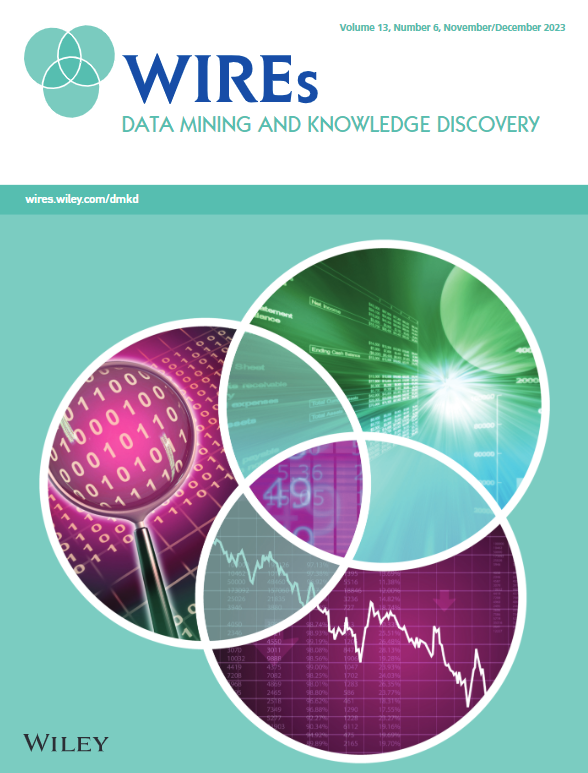Prediction model for recurrence of hepatocellular carcinoma after resection by using neighbor2vec based algorithms
IF 11.7
2区 计算机科学
Q1 COMPUTER SCIENCE, ARTIFICIAL INTELLIGENCE
Wiley Interdisciplinary Reviews-Data Mining and Knowledge Discovery
Pub Date : 2020-11-12
DOI:10.1002/widm.1390
引用次数: 0
Abstract
Liver cancer has become the third cause that leads to the cancer death. For hepatocellular carcinoma (HCC), as the highly malignant type of liver cancer, its recurrence rate after operation is still very high because there is no reliable clinical data to provide better advice for patients after operation. To solve the challenging issue, in this work, we design a novel prediction model for recurrence of HCC using neighbor2vec based algorithm. It consists of three stages: (a) In the preparation stage, the Pearson correlation coefficient was used to explore the independent predictors of HCC recurrence, (b) due to the low correlation between individual dimension and prediction target, K‐nearest neighbors (KNN) were found as a K‐vectors list for each patient (neighbor2vec), (c) all vectors lists were applied as the input of machine learning methods such as logistic regression, KNN, decision tree, naive Bayes (NB), and deep neural network to establish the neighbor2vec based prediction model. From the experimental results on the real data from Shandong Provincial Hospital in China, the proposed neighbor2vec based prediction model outperforms all the other models. Especially, the NB model with neighbor2vec achieves up to 83.02, 82.86, 77.6%, in terms of accuracy, recall rates, and precision.基于neighbor2vec算法的肝癌切除术后复发预测模型
肝癌已成为导致癌症死亡的第三大原因。对于肝细胞癌(HCC),作为高度恶性的肝癌类型,其术后复发率仍然很高,因为没有可靠的临床资料为术后患者提供更好的建议。为了解决这个具有挑战性的问题,在这项工作中,我们设计了一个基于neighbor2vec算法的肝癌复发预测模型。它包括三个阶段:(a)在准备阶段,使用Pearson相关系数来探索HCC复发的独立预测因子;(b)由于个体维度与预测目标之间的相关性较低,我们找到每个患者的K‐最近邻(KNN)作为K‐向量列表(neighbor2vec); (c)将所有向量列表作为机器学习方法的输入,如逻辑回归、KNN、决策树、朴素贝叶斯(NB)、并利用深度神经网络建立基于neighbor2vec的预测模型。从山东省立医院实际数据的实验结果来看,本文提出的基于neighbor2vec的预测模型优于其他所有模型。其中,基于neighbor2vec的NB模型在准确率、召回率和准确率方面分别达到了83.02、82.86、77.6%。
本文章由计算机程序翻译,如有差异,请以英文原文为准。
求助全文
约1分钟内获得全文
求助全文
来源期刊

Wiley Interdisciplinary Reviews-Data Mining and Knowledge Discovery
COMPUTER SCIENCE, ARTIFICIAL INTELLIGENCE-COMPUTER SCIENCE, THEORY & METHODS
CiteScore
22.70
自引率
2.60%
发文量
39
审稿时长
>12 weeks
期刊介绍:
The goals of Wiley Interdisciplinary Reviews-Data Mining and Knowledge Discovery (WIREs DMKD) are multifaceted. Firstly, the journal aims to provide a comprehensive overview of the current state of data mining and knowledge discovery by featuring ongoing reviews authored by leading researchers. Secondly, it seeks to highlight the interdisciplinary nature of the field by presenting articles from diverse perspectives, covering various application areas such as technology, business, healthcare, education, government, society, and culture. Thirdly, WIREs DMKD endeavors to keep pace with the rapid advancements in data mining and knowledge discovery through regular content updates. Lastly, the journal strives to promote active engagement in the field by presenting its accomplishments and challenges in an accessible manner to a broad audience. The content of WIREs DMKD is intended to benefit upper-level undergraduate and postgraduate students, teaching and research professors in academic programs, as well as scientists and research managers in industry.
 求助内容:
求助内容: 应助结果提醒方式:
应助结果提醒方式:


